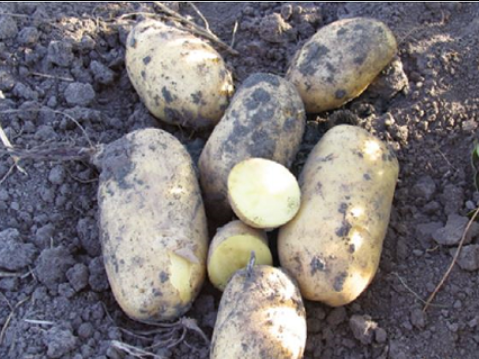Potatoes are a popular crop to grow in home vegetable gardens. However, there’s a lot to know about growing and harvesting potatoes properly. Iowa State University Extension and Outreach horticulturists have tips on growing, harvesting and addressing common problems sometimes seen on potatoes.
When should I harvest potatoes?Potatoes can be harvested when the tubers are small and immature, known as new potatoes, or when the crop is fully mature. New potatoes are dug when the plants are still green and the tubers are greater than 1 inch in diameter. New potatoes should be used immediately, as they do not store well.Potatoes grown for storage should be harvested after the vines have died and the crop is mature. To check crop maturity, dig up one or two hills after the plants have died. If the skins on the tubers are thin and rub off easily, the crop is not fully mature. Allow the crop to mature for several more days before harvesting the potatoes. When harvesting potatoes, it is best to avoid bruising, skinning or cutting the tubers. Damaged potatoes should be used as soon as possible.Before storing the potatoes, cure the tubers at a temperature of 50-60 degrees Fahrenheit and high relative humidity, about 85-90%, for two weeks. The curing process allows minor cuts and bruises to heal and the skin to thicken. Once cured, store potatoes at a temperature of 40 F and relative humidity of 90-95%.How can I control Colorado potato beetles?The Colorado potato beetle is difficult to control. The first line of defense is hand-picking. Remove beetles, eggs and small larvae by hand from infested plants as soon as they are noticed. Removing overwintering beetles that appear on young plants in spring is especially important. Hand-picking can be effective for a few insects on a few plants in smaller gardens but is impractical for larger gardens.Row covers can be used to exclude adult beetles from plants in spring and prevent egg-laying. This method is only effective if you are growing potatoes in an area where adults are not overwintering and will not emerge from the soil underneath the row cover. Control with insecticides is possible but difficult, as Colorado potato beetles have developed resistance to many of the commonly available insecticides. When using insecticides, consider timing, coverage and insecticide choice. Timing is critical. Small larvae are much easier to control. Only use insecticides labeled for use on Colorado potato beetle in the home garden and apply according to label directions. Spray early and spray often. Apart from synthetic pesticides, organic pesticides, such as spinosad and neem, can be used but are only effective on very young larvae.Why are my potatoes knobby?Fluctuations in soil moisture levels during tuber development may cause knobby potatoes. Watering regularly, about once a week, during dry periods will help prevent this problem.Why are my potatoes covered in rough, corky patches?Rough, corky patches on the surface of potato tubers are due to potato scab. Potato scab is caused by the bacterium Streptomyces scabies. Though unsightly, scabby potato tubers are still edible. Simply peel the potatoes before use.Potato scab is most common in alkaline soils (soil pH above 7). However, altering the soil pH is difficult and not practical for most home gardeners. The incidence of potato scab can be reduced by planting certified, disease-free potatoes in spring. Choose cultivars that possess good resistance to potato scab. Also, rotate the placement of potatoes in the garden. If possible, plant potatoes in the same garden area only once every three or four years.Why are some of my potato tubers green?The potato tubers were likely exposed to light in the garden or storage. The skin on tubers exposed to light turns green due to the formation of chlorophyll. The chlorophyll itself is not a problem. However, higher levels of glycoalkaloids also develop in the green tissue. Green tubers have a bitter taste when eaten. They may also cause an upset stomach and more serious health problems.Tubers with small green areas can be safely eaten if the green portions are cut off and discarded. It would be best to discard potatoes that are largely green.When growing potatoes in the garden, hill soil around the base of the potato plants to prevent the tubers from being exposed to light. After harvesting, store potatoes in a dark location.What are the small, round, green objects resembling miniature tomatoes on my potato plants?The small, round, green objects are the true fruit of the potato plant. Potatoes bloom in late spring, but most flowers dry up, drop from the plant and don’t develop into fruit. The fruit that do develop are relatively small and inconspicuous and often go unnoticed by most gardeners. Potato fruits are not the result of cross-pollination of tomatoes with potatoes. Tomatoes and potatoes belong to the Solanaceae or Nightshade Family. Because they are in the same family, the flowers on tomatoes and potatoes are similar. The shape of the fruit is also similar (albeit smaller).Potato fruits are of no real value. The small fruit should not be eaten as they contain a poisonous alkaloid (solanine). The fruit are not useful for planting purposes as potatoes don’t reproduce true from seed.

Comments
Submit a CommentPlease refresh the page to leave Comment.
Still seeing this message? Press Ctrl + F5 to do a "Hard Refresh".